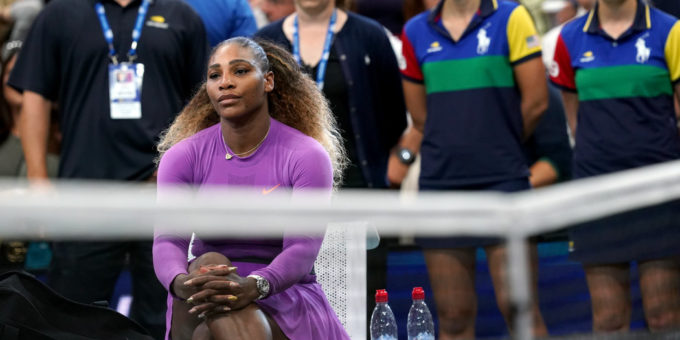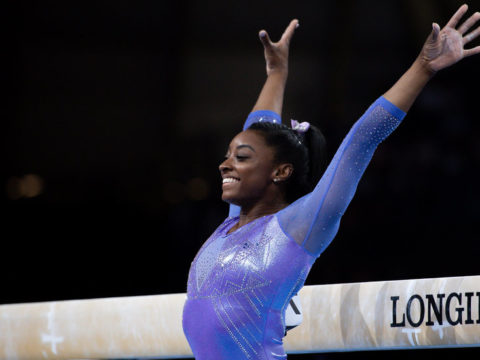
It felt like destiny, like Serena Williams was playing with the caress of fate.
Most everyone in the stands at Arthur Ashe Stadium expected her to win the United States Open on an electric Saturday afternoon.
Most everyone thought that she would beat Bianca Andreescu, the talented but still inexperienced 19-year-old Canadian, little known outside tennis circles until now.
This was supposed to be Serena’s day, a record-tying 24th Grand Slam singles title within her grasps.
How fitting it would have been, a win like that, after all she has been through. After losing each of the three major title finals she has played since nearly dying following the birth of her daughter in 2017. And yes, especially after last year’s final at the Open, the descent into chaos, the crowd bellowing in thunderous confusion as she battled with the chair umpire as hard as she did with her opponent, Naomi Osaka.
But it was not to be.
Once again in a Grand Slam final, Williams, 37, faced an opponent who simply brought too much game. Andreescu played a nearly flawless match from the opening points. Her only real hiccup came when nerves clamped down in the second set as she served twice for the match. She lost both games, giving Williams a sliver of hope. The stadium shook, a sea of fans wanting and needing the great champion to win.
But then Andreescu gathered herself in the exact way that we’ve seen Williams do time and again over the years. She breathed in deeply and owned the place, grabbing the title by breaking serve, winning the last game by striking yet another catapulting forehand winner that Williams could only watch sail by.
One hour and 40 minutes after the first ball was struck, the match was done: 6-3, 7-5.
“I know you guys wanted Serena to win, so I am so sorry,” Andreescu told the crowd during an on-court television interview. She smiled broadly. The crowd bathed her with warm applause.
Now comes the hard part: repeating that level of play, again and again, as only Williams has done in the modern era.
Given the context — the sterling form Williams was in coming to the final, the chance at redemption on the same court that brought unforgettable pain just last year — this loss will sting Williams as much as any.
“I believe I could have played better,” she said. “I believe I could have done more. I believe I could have just been more Serena today. I honestly don’t think Serena showed up. I have to kind of figure out how to get her to show up in Grand Slam finals.”
Her tone was doleful, but there is no reason for her to hold her head in shame.
It’s not just that she is 37, and deserves credit simply for still being at the highest reaches of the game at that age, doing battle against opponents who are still in their teens. Or that she is the mother of a daughter, Olympia, she clearly adores. Williams didn’t win this title, but it was once again evident as these past two weeks swept by that all of tennis, and this tournament in particular, remains beholden to her powerful sway.
Walk the grounds at the Billie Jean King Tennis Center and you could feel it in the way fans lined up on the practice courts to see her warm up. You could hear it in the way people gushed.
“Serena,” a little girl shouted, seeing Williams practice on a side court three hours before the title fight. The girl sprinted off to get a closer look, a pony tail bobbing against her back.
“Serena!” One word. All that was needed. Her popularity and influence — the way it is impossible to look away when her image flashes across a screen, the way she matters in realms far beyond the court — is of course an impact that few in sports have ever known.
And there is no tennis tournament where that impact can be felt as it was at this U.S. Open.
Before the final, fueled by the burning drive for history and redemption, the burning need to silence any doubters, she dominated.
There were matches that bordered on perfection. Recall the concussive groundstrokes that broke the will of Maria Sharapova: 6-1, 6-1 in 59 minutes. Recall the quarterfinal thrashing of Wang Qiang: 6-1, 6-0 in 44 minutes.
“I’m coming for it,” Williams uttered, as she looked out at the crowd once the Wang match was done.
Indeed she was.
If she had won here she would have done so exactly two decades after she first lifted the U.S. Open championship cup.
It is all too easy now, in an age of hyper-fast cyber time, to forget how she had marched through the tournament then as a lithe 17-year-old, her beaded braids flying defiantly as she defeated Martina Hingis to win it all.
Twenty years ago. Two crisp decades.
During the Open, Williams occasionally reflected on her past. She spoke about the big wins and big losses. She remembered her first tournaments here, noting that she had thought she’d be “retired at 28, 29, living my life.”
About her differences with the chair umpire she spoke only briefly, determined not to relive the past year.
“Yeah, I don’t know who that is,” she said when a reporter asked about the umpire.
Still, all around her was the future.
Once again this year, the Open was a showcase of young black female talent and determination. They are the virtual daughters of Venus and Serena, many drawn to the game by the enduring Williams sisters.
Not just the top-seeded Osaka, who made it to the round of 16 before losing in an upset. Not just the former champion Sloane Stephens. But also Taylor Townsend, who volleyed her way past Wimbledon champion Simona Halep in the biggest upset of the first week, and Coco Gauff, 15, who became the rage at a major tournament once again, just as she had at Wimbledon in July.
The surge of Black Girl Magic in tennis is likely just beginning. On the side courts, just out of view for the time being, five black American teenagers made waves in the junior girl’s singles draw, just over a quarter of the American girls in the event — pretty much unthinkable in the days before the Williams sisters.
It would be foolish, though, to think that the Williams effect is felt only by the growing number of young black women on the cusp of being pros.
It was there in the way Andreescu played the final — in her heavy strokes and brash confidence. “I’ve really strived to be like her,” she said of Serena Williams. “And who knows, maybe even better.”
The effect has clearly influenced many more than the young Canadian. You could see it these past two weeks: Asians, Europeans, Russians, South Americans and Africans all lean heavily on the booster-rocket tennis that Williams first showed the world in 1999.
99.
The grounds here burst with many tongues, every hue and every race, unlike the other Slams. With Serena leading, the Williams sisters have opened the U.S. Open to all comers, attracting fans who may never have paid attention to tennis at all.
“You can feel the diversity, which honestly shocked me,” said Lakisha Beverly, standing near the newly dedicated statue of Althea Gibson, the first black player to hold the title.
“I won’t ever forget seeing her,” Beverly said of Williams. “She’s grace and strength and beauty.”
She looked toward the Gibson monument, making the connection between Williams and her trailblazing forebear.
“Perfection,” she said.
To legions of fans at the Open, it would in fact have been perfect if Williams had somehow came back to vanquish her young challenger.
But it simply was not to be.
Credit: Source link













